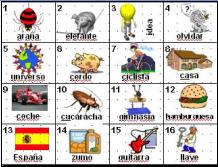Phonics
Teaching the sound-written links
Phonics is for me the point of departure for language learning whether introducing KS2 learners to a foreign language for the first time, beginning with an ab initio KS4 GCSE class or teaching adults.
What I mean by phonics is teaching the key sounds of the foreign language (‘key’ being those sounds that are written the same butpronounced differently in English) and fixing them in long-term memory by embedding them in words, often nouns but not always.
The words are learnt in a multi-layered way through seeing a vivid image, hearing and repeating the sound of the word and doing an accompanying gesture. The three strands of this VAK approach strengthen memory, making the knowledge robust and secure enough for easy retrieval at any time, and more importantly, for application to new words in new contexts.
The intended outcome is a learner who can be ‘trusted’ with the written text in the foreign language without the teacher having to present and pronounce the new language first, lest they should ‘manglicise’ (that is to say, mangle the pronunciation of a foreign language word by applying English patterns of pronunciation to it!) its pronunciation.
The consequence is also a learner who is able to understand more text containing unfamiliar language, a learner who is more confident in speaking and reading out loud in the foreign language, and a more autonomous learner who is able to make links between words and apply patterns.
Here is a fuller explanation of the above and a short film of the approach we use. We teach Spanish from Yr 7 and Spanish is also taught in our feeder primary school so there are more phonics materials available on the site than for other languages. There is also a short clip (sideways on!) of me and other teachers doing the phonics gestures. However, the first set of phonics used in our school was written for our German Yr 8 beginners by Leigh McClelland. The German Jollyphonics lesson is still the first German lesson we teach to Yr 8 classes. French phonics? Well, maybe not as straightforward as Spanish or German but we do teach them - we're still adapting the model but the current version is available here, as well as other French versions of phonics developed by other French teachers around the country.
Phonics resources
| Spanish | German | French | Italian |
|---|---|---|---|
| Spanish Phonics Spanish Phonics (KS2 version - adapted by Leigh McClelland) |
Jollyphonics (written by Leigh McClelland) |
Francophoniques - all Francophoniques - posters Notes on pronunciation French Phonics 1 (written by Kathy Collier) French Phonics 2 (written by Stephanie Reid) French sounds - key words (Vincent Everett) |
Italian Phonics (written by Noemie Neighbour) |
After the initial lesson(s) to teach the phonics words (with gestures), regular practice in applying the knowledge to the pronunciation of new words with the same sound-written relationship is required! There are lots of really good ways to do this. Here are some examples. More materials for Spanish in particular are described in Curriculum Now, and available with the online materials that accompany it.
Phonics weblinks for French, German and Spanish material.
| Spanish | German | French | |
|---|---|---|---|
| Tongue Twisters | Trabalenguas Cuchara Pancha plancha Pedro Pereira Links to Spanish tongue twisters 1 2 |
Acht Ameisen Bierbrauer Braun Allergischer Algerier |
|
| Rhymes/Sayings | Eeny Meeny Miny Mo (Spanish version!) | Alles hat ein Ende Der Tausendfussler German Phonics starter |
|
| Cognates | 2-syllable cognates 3-syllable cognates (written by Caroline Grant) Cognates Listening Starter |
||
| Cartoons | Mafalda Garfield/Calvin & Hobbes Mr Men starter |
Mr Men - list of names in French, German and Spanish | Mr Men - list of names in French, German and Spanish |
| Headlines/Short News Stories | See weblinks download | ||
| More activities | DLAB (adapted from the US Defence Language Aptitude Battery) starters Clasificacion de palabras 1 Clasificacion de palabras 2 Starter - World Cup Winners |
Phonics pictures - find the link (written by Starr Green) Additional French phonics resources can be found here: 'Tons of stuff' |
There is a lot of phonics practice embedded within our Yr 7 Scheme of Work too and all the resources are on this site under Resources - Yr 7. As an example of how well phonics work can be fitted into units of work, here is a stand alone module of 9-12 lessons called 'I Spy'. The original French version was written and developed in a Norfolk LA languages project, led by Adam Cooke. Those materials can be found on the Norfolk LA website. In my adapted Spanish version I have included 4 different phonics starters. Here are all the resources.
The NCELP website includes a huge amount of useful material related to phonics, including professional development, presentations and resources.